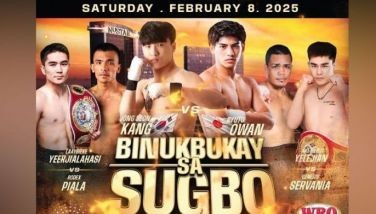Suspicions resurface about Marcos heroism

Hired guns again struck separate targets two government men and a lawyer in the past two weeks in Luzon. The modus operandi: “two helmeted men, riding tandem on a motorcycle,” drew close enough for a sure hit, then fled through city traffic. It’s been the pattern in assassinations in the past five years. But the National Police has not established a central file. Much more, a repository of evidence, like bullet slugs, or artist sketches and other items that can establish commonality.
The excuse is that the National Police lacks funds and know-how. And yet it has Directorates for Intelligence and for Investigation and Detective Management that supposedly specialize in crime prevention and solution. Their operating arms, the Intelligence Group and the Criminal Investigation and Detection Group, have not instructed the various field stations and precincts on dealing with potential assassins. Proof perhaps was the recent arrest of six armed men in a car in Metro Manila. On suspicion of being robbers, the police booked them for illegal possession of firearms, for which the latter posted bail. There was no check if they were murderers-for-hire.
* * *
Was Ferdinand Marcos truly a war hero? Or did he just concoct his battle exploits and medals for political capital? The questions first emerged 25 years ago, when the reigning strongman faced off with a challenger-widow for the Presidency. As in all his election runs, Marcos in 1986 had claimed war gallantry to look abler than housewife Cory Aquino. But the concomitant exposure of his 27 war medals as fake dented his image and contributed to his loss in the balloting. Weeks later while refusing to turn over power, a civilian uprising toppled him from a 14-year military rule.
So, was Marcos a World War II hero? Or was he a heel linked to sellers of contraband to the enemy, but who depicted himself as valiant for personal and political gain? The doubts resurface today, when most Filipino youths and probably elders too couldn’t care less about the long-dead Marcos. But then, 204 congressmen are egging Malacañang to re-inter Marcos at the Libingan ng mga Bayani (Resting Place of Heroes). And the Armed Forces has just inaugurated a Hall of Heroes featuring 39 Medalists of Valor, including Marcos.
Marcos’s daring war adventures first saw print in a 1948 magazine series. The young lawyer supposedly had formed a 9,200-strong guerrilla group called Mga Maharlika (The Nobles) in North Luzon. Unmindful of danger, he led more than 300 skirmishes with the mighty Japanese Imperial Army, for which he was decorated 27 times. Thus did Marcos earn in 1947 a post in the Philippine commission that lobbied with the US for veterans’ benefits. Riding on the daredevil acclaim, he handily won in 1949 a congressional seat.
If there were doubts then about Marcos’s claims, nobody said so aloud. Only in 1982 did war vets begin to murmur, when Marcos, ten years into his military rule, alleged himself to be the real hero of the Battle of Bessang Pass. Overrunning the gorge was vital to the US Army’s pursuit of General Yamashita in the Cordillera Range. Marcos mentioned General Volkmann as confiding that Yamashita almost surrendered to the Maharlika guerrillas. War historians grumbled, for nowhere was Marcos near the battleground.
Marcos’s war hero image collapsed when The New York Times ran an exclusive on January 23, 1986. He was then wrapping up the election campaign against Cory, widow of Ninoy Aquino. As usual he regaled the crowds with accounts of his hot exploits. The Times doused cold water on his stories, quoting the US Army description of them as mostly “absurd” and “fraudulent”. Main source was Alfred W. McCoy, a history professor who was researching records just turned over to the National Archives in Washington. McCoy unearthed two requests by Marcos in 1945 and 1948 for official recognition of Mga Maharlika. Both were rejected as Army investigators found the claims to be exaggerated. Ray Hunt Jr., an ex-Army captain who directed guerrilla activities in 1942-44 in Pangasinan, North Luzon, was quoted in the Times article as saying the Maharlika was fictitious. He said if any unit had operated near his base then, he would have known about it. The investigators said Marcos even associated with men engaged in “nefarious activity,” like supplying contraband to the Japanese.
The opposition press picked up the Times story. It confirmed what retired Philippine Army Col. Bonifacio Gillego had stated only months before in The Fake Medals of Marcos. The underground book branded the 27 decorations as outright phonies or awarded through bogus accounts. Also exposed then was Marcos’s rejected application for war reparation of $595,000. Supposedly it was for the US Army’s commandeering of 2,000 heads of cattle from his (inexistent) family ranch in Mindanao.
Marcos ordered political lieutenants to refute the reports. They came up with a more incredible claim that the medals were for acts in 1941 and 1945, at war’s beginning and end. This only lent more credence to Gillego’s statement that, for Marcos to have fought the 27 battles, he would have been at different places at the same time.
* * *
Catch Sapol radio show, Saturdays, 8-10 a.m., DWIZ (882-AM).
* * *
E-mail: [email protected]
- Latest
- Trending

























